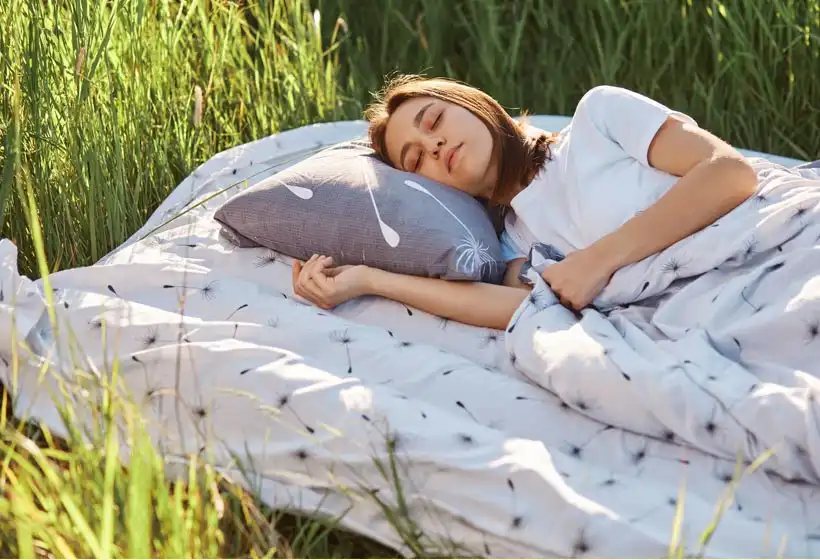Green Noise Benefits: How It Can Better Sleep?

I’m curious if you have problems getting to sleep at night. Do you feel worn out, foggy, or agitated when you wake up?
Then you are not by yourself.
The National Heart, Lung, and Blood Institute (NHLBI) estimates that 70 million Americans experience a sleep disturbance of some kind. I’ve discovered that getting too little sleep has an impact on mental and emotional health. It affects relationships, performance, and productivity as well.
How does noise have a big impact on how well you sleep?
Unwanted or hazardous sound can come from a variety of sources. It includes airplanes, construction, snoring partners, sirens, alarms, and traffic. Noise interferes with sleep. It decreases the quality of sleep, and elevates stress levels.
But what if there was a way to use sound to improve your sleep? What if you could listen to the soothing and calming sounds of nature and drift off to dreamland?
This is where green noise comes in handy.
Let us explore!
What Is Green Noise?
Green noise is a type of sound that mimics the natural sounds of the environment, such as birds, water, wind, or leaves. It is similar to white noise, which is a sound that has equal loudness across all frequencies, but with a lower pitch and a more natural feel.
Green noise can be a great alternative to white noise for people who find white noise too harsh, boring, or artificial.
Green Noise for Sleep: Science Explained
I have examined the effects of an array of sleep sounds on auditory spectrum. It involves understanding their distinct characteristics.
Dr. Laura Purdy notes the differences: “Pink noise lowers pitch by reducing higher frequencies, offering a soothing quality. Brown noise, emphasizing lower frequencies even more than pink noise, may sound ‘coarser,’ similar to a robust wind or a rushing river.”
Research supports the efficacy of these sounds in facilitating sleep. A 2022 study cited in The New York Times found that white noise significantly reduced the time it took participants to fall asleep by 38%, compared to normal environmental noise.
Pink noise, according to another study, proved most helpful in minimizing the challenging “trying to fall asleep” period. Additional variations, such as brown, purple, and blue noise, show potential for inducing sleep, though with less research support.
Beyond their role in sleep, color noises like pink noise might extend benefits to workplaces by enhancing sleep and work productivity. This nuanced understanding can guide individuals in selecting the most suitable color noise for their sleep preferences and potentially exploring broader green noise apps beyond the realm of sleep.
Green Noise Sound: What Is It Like?

Psychologist and primary care physician Dr. Laura Purdy articulates “green noise is like an ambient noise in nature.” She notes that for some individuals, green noise proves to be more soothing compared to brown noise.
Green noise, characterized by powerful mid-range frequencies, replicates the serene sounds of nature, such as ocean waves or a flowing stream. In contrast, white noise, retaining high frequencies, may exhibit a continuous hissing akin to static on electronic devices.
The gentler quality of green noise, achieved by limiting harsh high tones, imparts a more calming auditory experience. Similarly, pink and brown noise, sharing mid-range and lower frequencies with green noise, evokes natural sounds like a water sprinkler or falling rain (pink noise) and deeper tones reminiscent of thunder or a jet engine (brown noise).
Green Noise vs White Noise: Know the difference!
Green Noise vs. White Noise
White noise and green noise differ in their frequency components and auditory characteristics. White noise has an equal distribution of frequencies across the entire spectrum, resulting in a constant hiss or shushing sound.
In contrast, green noise 500 Hz frequency is low, resembling nature sounds like rustling leaves or rain. Many individuals find green noise more relaxing and soothing compared to the continuous hiss of white noise. The tonal quality of green noise is often described as more natural, contributing to its appeal for promoting a calming auditory environment.
While discussing white noise vs. green noise, it can be seen that green noise features more low-frequency components, creating an auditory experience reminiscent of nature sounds like rustling leaves or rain. Many people find green noise more relaxing than the constant hiss of white noise, attributing its appeal to a natural tonal quality.
Green noise extends its benefits beyond relaxation, promoting heightened cognition, improved focus, and reduced daytime stress. Its evenly distributed frequencies facilitate smooth transitions between non-REM and REM sleep cycles, contributing to a restful night’s sleep.
Particularly beneficial for those with unpredictable schedules or living in busy cities, green noise offers a calming and unwinding effect, enhancing the ease of falling asleep.
What Are The Other Types of Noises?
Now that you have an idea about green noise vs. white noise let’s learn more about other types of noise. Other calming noises are fast gaining popularity in our times. Some of these are cited below:
- Pink noise: Balanced and less hissy than white noise, pink noise maintains equal energy across octaves but decreases in intensity as the frequency rises.
- Brown noise: With heightened energy in lower frequencies, brown noise is likened to a deep rumble or a waterfall, prized for its relaxing and masking properties.
- Blue noise: Featuring more energy in higher frequencies, blue noise creates a crisp and sharp auditory experience, potentially invigorating and aiding concentration.
Green Noise Benefits
So, what does green noise do?
Green noise offers certain benefits for sleep and well-being, as discussed below.
1. Promotes relaxation
Green noise can help you relax by creating a soothing and calming atmosphere in your bedroom. It can also lower your heart rate, blood pressure, and stress levels, which are all important for falling asleep and staying asleep.
2. Masks other sounds
Green noise can help you block out any distracting or disturbing sounds that may keep you awake, such as traffic, snoring, or noisy neighbors. By masking these sounds, green noise can help you focus on the pleasant sounds of nature and fall asleep faster.
3. Enhances mood
Green noise can help you boost your mood by stimulating positive emotions and memories associated with nature. Studies have shown that exposure to natural sounds can increase happiness, creativity, and empathy. These effects can also carry over to the next day, making you feel more refreshed and energized.
4. Supports brain health
Green noise can help you improve your brain health by enhancing your memory, attention, and learning abilities. Research has found that listening to natural sounds can improve cognitive performance, especially in tasks that require sustained attention and working memory. This can also help you prevent cognitive decline and dementia in the long term.
Green Noise Benefits: Who Might Get The Most?
Insomnia expert Dr. Kristen Casey sheds light on the link between calming sounds and sleep.
Dr. Casey suggests, “For some individuals, a lack of noise can induce anxiety.”
She recommends various forms of white noise like green, pink, or brown noise and emphasizes their role in providing a sense of mental safety by creating a background noise that doesn’t trigger awakenings, potentially fostering better sleep.
Individuals who want to drown out surrounding noises may find it beneficial for promoting sleep.
- Shift workers dealing with loud city traffic, for instance, could explore green noise via a green noise machine.
- Infants may also experience positive effects, potentially reducing night-time crying.
- Additionally, those grappling with racing thoughts and anxiety might find relief, as the soothing sounds in green noise provide an alternative focus, potentially aiding in better sleep.
Green Noise Benefits in Sleep and Health?

While specific research on the health benefits of green noise is lacking, studies on nature-inspired sounds akin to green noise reveal potential advantages. So, let’s learn what green noise is used for.
Green Noise Benefits
- Enhanced Cognitive Performance
Experiments with college students using a nature-sound green noise app featuring rainfall and waves similar to green noise demonstrated improved cognitive performance, including better working memory and alertness, suggesting potential benefits for attention and focus.
- Faster Stress Recovery
Research on the impact of natural sounds on stress recovery found that exposure to these sounds helped individuals recover faster from stress than those exposed to man-made sounds, indicating a potential quality of stress relief.
- Sleep Improvement
While no studies specifically focus on green noise, research on green noise machines akin to those used for green noise suggests effectiveness in drowning out distracting noises, potentially aiding better sleep. Green noise and similar sounds like pink noise have shown promise in easing the brain into slow-wave states and enhancing overall sleep quality.
What Noise is Best for Sleep? How to Find It?
Sleep experts emphasize that finding the ideal sound for sleep is a personal journey and requires experimentation.
Dr. Kristen Casey discourages sleeping near television noise due to its potential to disrupt the sleep cycle. Instead, she suggests white, green, pink, or brown noise as alternatives for addressing the diverse spectrum of over 70 sleep disorders.
Follow these simple steps to identify the type of sound that is aligned with your needs.
- STEP 1: Adjust your volume and choose a frequency that aligns well with your psyche and needs.
- STEP 2: Next, set up a timer aligned with your sleep onset time to ensure an effective yet controlled experience.
- STEP 3: However, for persistent sleep issues impacting daily life, seek professional medical advice, as green noise machines should not substitute comprehensive medical attention.
Top 4 Tips to Use Green Noise for Sleep
If you want to try green noise for sleep, here are some tips to get you started:
1. Tip 1: Choose a sound that you like
There are many types of green noise that you can choose from, such as rain, ocean, forest, or stream. You can also mix and match different sounds to create your own custom soundscapes. The key is to choose a sound that you find relaxing, enjoyable, and familiar. You can experiment with different sounds until you find the one that works best for you.
2. Tip 2: Use a green noise machine or a green noise app
The easiest way to play green noise in your bedroom is to use a green noise machine or a green noise app that offers green noise features. You can find many options online or in your local store. Some sound machines and apps also allow you to adjust the volume, pitch, and duration of the sounds to suit your needs.
You can also set a timer or a fade-out function to turn off the sounds automatically after a certain period of time.
3. Tip 3: Use headphones or speakers
Depending on your preference, you can use headphones or speakers to listen to green noise. Headphones can offer more privacy and immersion, but they can also be uncomfortable or fall off during the night. Speakers can offer more convenience and comfort, but they can also disturb your partner or roommate.
You can also use a pillow speaker or a headband speaker to get the best of both worlds.
4. Tip 4: Use green noise throughout the night
To get the most benefits from green noise, you should use it throughout the night, not just before bedtime. This can help you maintain a consistent and peaceful sleep environment and prevent any interruptions or awakenings. You can also use green noise during the day to relax, meditate, or work.
Smart-Take!
In this article, I wanted to share my observations and experiences with you after learning more about the advantages of green noise. Green noise is a kind of sound that has a more even and well-balanced frequency range.
It has a calming sound of nature. In my experience, it can improve sleep quality by fostering calmness. It blocks out outside noise, elevating mood and bolstering mental well-being.
The following is what I’ve found to be effective if you want to try using green noise for sleep:
- Selecting a Sound: Look for a green noise that you enjoy. Choose the choice that speaks to you from the many that are available by taking your time.
- Using an App or Sound Machine: I use a green noise app, but there are several green noise machines out there as well. Both are capable of producing a continuous stream of green noise all night long.
- Using Speakers or Headphones: You can use speakers to fill the space with sound or headphones, depending on your desire, for a more private experience.
- Consistency: I’ve found that using green noise all through the night has helped me get better quality sleep.
There are many advantages to using green noise. It’s a method to improve the quality of your sleep and your general well-being. It is particularly suitable if you enjoy the outdoors and want to include some of nature’s soothing elements in your bedroom.
To enhance your experience with green noise, I suggest visiting SmartMattressBuy. We provide a selection of mattresses made to meet your demands for support, comfort, and affordability. Come see us now for a restful slumber.
Visit our Best Time to Buy a Mattress page to find great deals!
Frequently Asked Questions on Green Noise
- Can green noise improve sleep quality?
People often wonder about what green noise is and how it can improve sleep. Green noise is characterized by its calming and natural attributes and promotes relaxation, easing the transition into sleep.
Notably, it has demonstrated the ability to normalize heart rate variability, preparing the body for restful sleep by creating a tranquilizing effect in the pre-sleep period.
- Which color noise is most beneficial for sleep?
Green and brown noises are believed to aid in falling asleep, with brown noise showing potential for improved sleep maintenance. Additionally, pink and white noise are recommended for sleep due to their capacity to block external sounds, collectively offering diverse options for optimizing sleep environments.
- How can the sound of green noise be described?
Green noise, akin to white noise with uniform energy across frequencies, stands out for its gentler quality compared to the harshness of static. It specifically highlights mid-range frequencies at around 500 hertz (Hz). Some market green noise as a nature-mimicking auditory experience, resembling soothing sounds like waves on the beach or a gentle rain.
- What sounds are most effective for inducing sleep?
Sleep-inducing sounds, such as rhythmic and soothing white or pink noise, play a role in promoting deep sleep. Furthermore, the intentional use of binaural beats and theta waves is designed to decelerate brainwaves, facilitating a smooth transition from light sleep to the more profound stages of sleep.
Disclaimer
The information I share is intended to provide basic recommendations. It is based on my experience and viewpoint. It is not meant to be used for diagnosing mental health or sleep disorders. I strongly advise seeking individualized advice and direction from a healthcare expert prior to making any modifications to your sleep schedule.
References
- Luo, J., Wang, M. and Chen, L., 2021. The effects of using a nature-sound mobile application on psychological well-being and cognitive performance among university students. Frontiers in Psychology, 12, p.699908.
Link: https://www.ncbi.nlm.nih.gov/pmc/articles/PMC8651610/ - Alvarsson, J.J., Wiens, S. and Nilsson, M.E., 2010. Stress recovery during exposure to natural sound and environmental noise. International journal of environmental research and public health, 7(3), pp.1036-1046.
Link: https://www.mdpi.com/1660-4601/7/3/1036 - Lu, S.Y., Huang, Y.H. and Lin, K.Y., 2020. Spectral content (colour) of noise exposure affects work efficiency. Noise & Health, 22(104), p.19.
Link: https://www.ncbi.nlm.nih.gov/pmc/articles/PMC7986458/ - Johnson, B.S., Malecki, K.M., Peppard, P.E. and Beyer, K.M., 2018. Exposure to neighborhood green space and sleep: evidence from the Survey of the Health of Wisconsin. Sleep health, 4(5), pp.413-419.
Link: https://pubmed.ncbi.nlm.nih.gov/30241655/ - Zhong, C., Yin, X., Fallah-Shorshani, M., Islam, T., McConnell, R., Fruin, S. and Franklin, M., 2023. Disparities in greenspace associated with sleep duration among adolescent children in Southern California. Environmental Epidemiology, 7(4), p.e264.
Link: https://www.ncbi.nlm.nih.gov/pmc/articles/PMC10402945/ - Chan, T.C., Wu, B.S., Lee, Y.T. and Lee, P.H., 2024. Effects of personal noise exposure, sleep quality, and burnout on quality of life: An online participation cohort study in Taiwan. Science of the Total Environment, 915, p.169985.
Link: https://www.sciencedirect.com/science/article/pii/S0048969724001190







